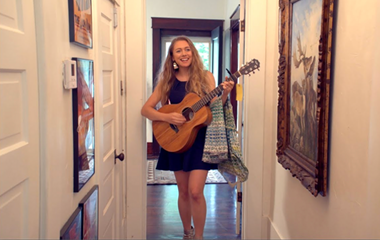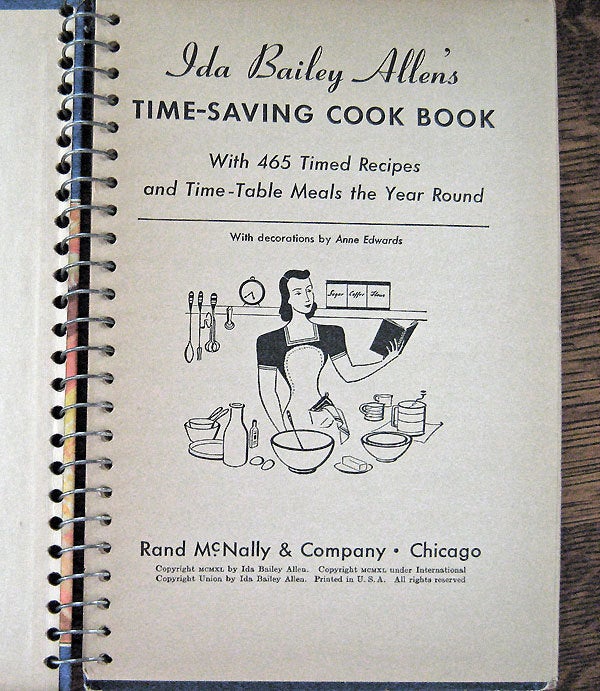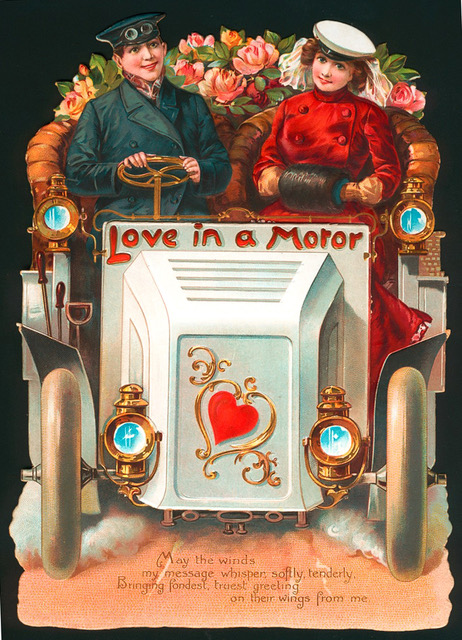A cursory look at the auction items offered in the section of ebay at Pottery & Glass > Glass > Glassware > Early American Pattern Glass, could leave a person slightly bewildered. You have to wonder why some choose that section which is designated specifically for 19th century American pressed glass to list their item, especially when their auction item is glass made in the mid 20th century or even pottery.
One explanation may be date related. The term “Early” is subjective. “Early” to many, means “before I was born” or certainly “before my parents were born”. Another is that Early American Pattern Glass, or EAPG, is simply a widely misunderstood catch-all term that is interpreted as “glass I want to sell”.
Another point of confusion is that this glass with a very narrow definition is known by so many terms. The two most obvious are Early American Pattern Glass and EAPG, but it is also referred to in the literature and in current vernacular as ʻpressed glassʼ, ʻpattern glassʼ, ʻold glassʼ, ʻCivil War glassʼ, ʻVictorian glassʼ, and even ʻEarly American Pressed Glassʼ. For simplicity, weʼll use ʻEAPGʼ as we attempt to unravel the mystery here with some basic well-known Building Blocks and give you the A B Cʼs of EAPG.
“A” is For Age
The definition of EAPG in itʼs simplest form is: glass dishes pressed into a mold, in America, between 1850 to 1910 in sets, such that all the pieces of the set match in design.
“Wait!”, youʼre saying. I have a collection of Bird & Strawberry pattern that was made in 1915! Right. Youʼve just identified one of the conundrums of EAPG. A few glass companies made patterns that were so popular that they continued making them after 1910 and some glass companies, notably Indiana Glass Co., Indiana Dunkirk & Kokomo Jenkins, introduced a few patterns that had that “Victorian” aura for a few years after 1910.
“Wait!”, you say. I have some glass that was pressed in America before 1850! Right. Another conundrum… glass was pressed in America before 1850. But mostly those pieces were limited to salt dips, curtain tiebacks, candlesticks, dresser knobs and a few other items…. not “kitchen dishes”…but they are sometimes cast into the net of EAPG anyway. No one ever said that the antiques world is rigid.
For the record, a body of collectibles needs to have somewhere to begin and end and most, for simplicity, have chosen 1850 -1910, the Victorian era. And so, EAPG does have a date definition, even if it is a little elastic.
One helpful way to look at EAPG is to divide the 60 (or so) years it was made into 4 Periods or Ages.
The Lacy Glass Age 1825-1845
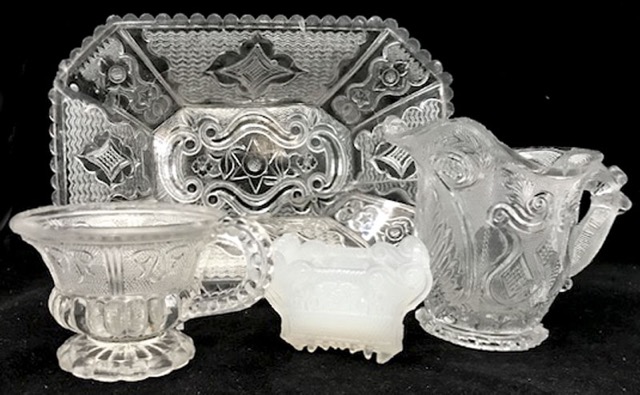
Lacy is a general term chosen by collectors to describe the earliest type of pressed glass produced in the US. “Lacy” refers to the look of these early patterns; they are replete with scrolls & geometric designs against a finely stippled background which gives the glass the look of fine lace. Truth be known, that fine stippling doubled as an inventive way to mask the irregularities in the glass.
This glass was formerly referred to as “sandwich glass” for the Boston & Sandwich Glass Co. of Sandwich, Mass, which produced a great deal of this ware. Today, it is realized that many other factories on the East Coast & in the Pittsburgh, PA and Wheeling, West Va areas also made lacy looking glass. The first pressed glass pieces made were drawer pulls, cup plates, master salts, curtain tie backs and later there were perfume bottles, decanters & some dishes. Although they were not yet made in larger “sets”, we own one very rare covered sugar bowl & creamer set (the creamer is shown in the above photo). Lacy glass was rarely made in colors and most of that is now in museums. All Lacy glass is flint (leaded) glass and if you own some, you have some examples of American historical treasures.
Colonial Age 1845-1865
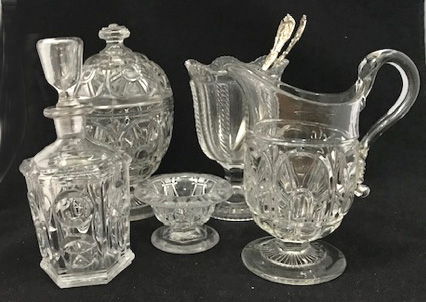
Here ends the Lacy Age and begins the transition to the Flint Glass Age. Up until the time of the Civil War, American pressed glass contained a high lead content and is known today as “flint Glass” or “lead glass”. A frequently asked question about lead glass is whether or not it is safe to use for eating and drinking. Yes, it is. The lead is bound up in molecules, which do not deteriorate or come apart. Having said that, it is not recommended that decanters, etc. be used to store any liquids over a long period of time because of the risk of causing discoloration of the glass. Flint glass is exceptionally clear with a familiar ringing quality when gently tapped. During this Age we see the emergence of glass dishes in recognizable and named patterns. Various forms of dishes produce a more distinct “ring” than others.
Each pattern might consist of simply goblets or of matching various sized drinking vessels, whale oil lamps, celery vases, decanters, sugar bowls, spill holders, butter dishes & creamers. Some bowls, compotes (bowls on a stand),and pitchers were made in these early years. A form that was only made during a short time span were spill holders – heavy glass footed vases intended to hold the burned wooden “spills” – sticks used to light fires.
The creamers & pitchers mostly had applied handles made by attaching a molten strap of glass onto a molded body. Applying this hot strap to the cooled body frequently resulted in a ʻstress fractureʼ or ʻheat checkʼ at the attachment point, which were understandably common in these pieces. Later in this period, spooners and pomade or pickle jars were added to the forms made.
During the 1860ʼs, changes in the availability of elements, including lead used in the formula for glass necessitated in part by the Civil War, caused the dishes to take on different physical characteristics. They were lighter weight, less expensive, less clear and exhibited no bell tones. On the positive side, it was better able to create more elaborate designs in the glass. We now call this type of glass ʻnon-flintʼ or “soda lime” glass. With improved glass pressing machinery, mass production began and matched tableware sets began to proliferate. A few glass companies, including Boston Sandwich, continued to make some of the higher priced lead glass dishes until the 1870s.
The idea of a matched glassware table service quickly caught on in America. Many patterns had numerous accessory pieces among which were cruets and syrup pitchers. During this time, tall pieces such as high standard compotes and cake stands were made in 2 parts and had “wafer” connections. A small dab of molten glass was put between the top and the standard (base) which, when cooled, stuck the 2 pieces together (forming the wafer) although sometimes not totally on the same plane leaving the finished product a little tilty or twisty.
Post Civil War Age 1865-1870ʼs
After the War, pressed glass began to be made in larger quantities. The number of patterns expanded & changed from being mostly geometric & ribbed styles to folksy naturalistic designs which reflected current trends in home fashions. Americaʼs Centennial was celebrated in 1876 and many more glass patterns were introduced. Lots of stars were stylishly employed and commemorative objects were made that exhibited the pride Americans had in our Country.
Some glass dishes during this Age were “fancied up” by frosting, by sand blasting, grinding or chemical exposure; copper wheel or stone wheel engraving; some acid etching and other colorless decor. It is interesting how many collectors & even sellers confuse engraving and etching processes on EAPG. In a nutshell, if the decoration is cut into the surface of the glass (you are able to feel the ‘catch it’ with your thumbnail) it is probably engraved and if it is smooth to the touch, it is probably etched. By far, most EAPG is decorated by engraving with only a handful of whole pattern lines, such as Ohio and Pavonia being etched. A few etched patterns, such as Deer & Dog and Flamingo Habitat show scenes or tell a story.
The Golden Age of Pressed Glass 1880-1910
By the 1880ʼs pattern glass was produced in great volume in hundreds of patterns, and colored glass came into vogue. The 1880ʼs was the ʻHey Dayʼ of Pattern Glass – color became King. Astronomical quantities were sold in dime stores, through catalogs such as Sears & Montgomery Wards and some pieces were given away as premiums in soap, oatmeal, jelly, etc. by companies such as the Lee Mfg. Co. of Chicago.
The “Gay ʻ90ʼs” began with a severe nationwide economic depression, necessitating the closing of many smaller glass companies many of which turned over their most valuable tangible assets, their molds, to larger conglomerates. The largest such combines were the U S Glass Co. and the National Glass Co.. This group strategy allowed the continued production of most patterns, although many were renamed and altered slightly in design when the molds changed hands. As a marketing technique, the largest combine, U S Glass Co., began naming patterns after states of the Union, sometimes simply renaming old patterns & sometimes introducing new patterns named for a particular state.
Decorating pattern glass became even more popular during the 1890s and we find cased, stained, & flashed colored decor as well as the colorless embellishments which were also still being used. The ruby staining of souvenir glass was very popular during this time and emerald green colored glass was made for the first time in the 90s.
The production of the Statesʼ series continued into the first decade of the twentieth century, but by about 1910, the designs began to loose their Victorian flavor taking the look of the fancier cut glass. In fact sometimes these patterns are now referred to as “Cut Glass Lookalikes”. Demand for the use of Victorian pressed glass declined by 1915, and glass fanciers were collecting EAPG by the 1930s.
“B” Is for Basic Forms
And then there is the riddle of what glass is actually included in this family friendly collectible field. We use the word “form” to designate different pieces of patterns – goblet, sugar bowl, mustard pot, etc..
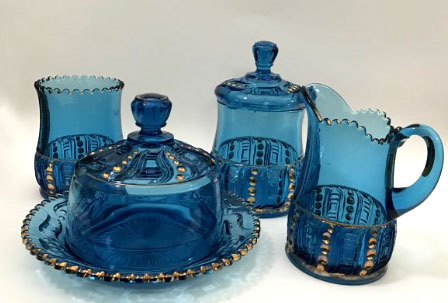
The Basic set of EAPG dishes is the “Four Piece Table set”. Every pattern (almost) that was made in more than one form, came in a Table Set. This is a specific term that includes a covered butter dish, a covered sugar bowl, a creamer and a spooner. A what? A spooner – also called a spoon holder or even a spill. It holds spoons and sits on the table or cabinet top so if someone wants a spoon, it is handy.
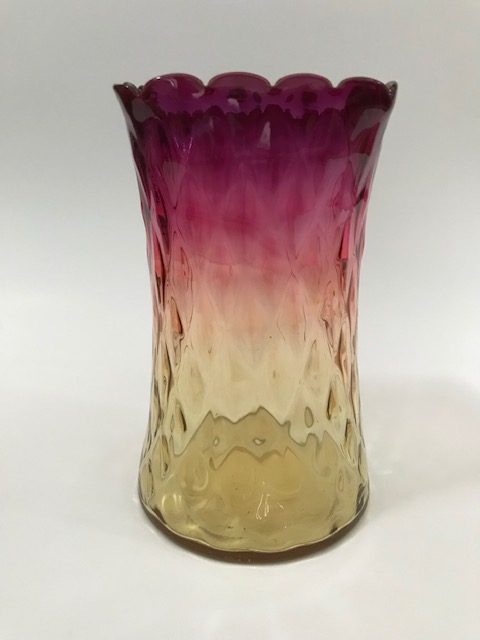
After the Table Set, a pattern would probably include a “Celery Vase”. Actually almost from the beginning of pressing glass, every pattern line of any consequence included one of these containers – shaped like a vase and purported to be used to hold, of all things, celery!! Now, it is almost certain that Victorians ate more potatoes or tomatoes than celery, but there were not potato dishes or tomato vases. So – Why a Celery Vase? – this is a mystery the answer to which we can only guess. One good guess might be connected with the idea of the level of taxes levied on vases…. but we don’t know enough about that to confirm it,
Next in common production is probably the “Berry Set” (Victorians were big on Sets). A “Berry Set” consists of a Master Berry Bowl – usually around 7-9” in diameter – and 4-8 smaller matching berry bowls or “sauce dishes” – usually 3 1/2” – 5” in diameter. Some of these were flat and some were footed e.g. on a short pedestal like what we commonly think of as sherbet dishes. Where the term got the word “berry” is interesting because berries were certainly not available in quantities large enough to fill those bowls by most Victorian age housewives who used this glass.
Then comes the “Water Set”. This can also vary, depending on the pattern and the glass maker, from a pitcher & 2-6 tumblers; or a pitcher and 2-6 stemmed goblets; or a pitcher and tumblers or goblets and a water tray; or a pitcher, some drinking vessels, a tray and a waste bowl!

Patterned sets of dishes are by far the main focus of EAPG collectors but there are some exceptions to even that! Many, many patterns were made in only one form, the main category being goblets or other drinking vessels. Then there are oil lamps, novelty items and condiment containers that held syrup, salt & pepper, oil, vinegar or mustard.
A few sets of childrens’ or toy dishes were made to match their kitchen sized pattern lines. Hawaiian Lei, Two Band, Lion Head, Liberty Bell and Sawtooth come to mind.
Bread plates, which were made in most patterns but also in some stand alone designs, are popular EAPG collectibles and they also make unique wedding gifts. Many of them had embossed mottos on the center or edge such as “A Good Mother Makes a Happy Home”, “It is Pleasant to Labor For Those You Love” and several Bible verses, most often, “Give Us This Day Our Daily Bread”.
There are also some fun & useful glass forms made for sundry purposes such as holding toothpicks, matches, cards, condiments and such, that donʼt necessarily match a pattern but are irresistible to “old glass” folks.
“C” Is for Companies
From the first company to press glass (this is an unresolved issue but weʼre pretty sure it is in New England) through the end of the 19th century, hundreds of companies practiced pressing glass into molds. They turned out millions of pieces of inexpensive “ware” and were in fierce competition for the Trade (ie – the business of homemakers). Most of the later companies were along the Ohio River Valley from Pennsylvania and West Virginia to Ohio and Indiana because of the natural gas that was found there. In the aforementioned 1891 deep National depression, most of those which had not burned down went bankrupt. Some preserved their assets by forming combines, namely the U S Glass Company and the National Glass Company.
As if the national economic woes were not enough, the tastes of American women changed with the times – from florals to a fascination with all things oriental, to animals (e.g. Grasshopper pattern, some forms of which featured actual insect likenesses on the sides), plants, shells, diamonds & of course curly queues. A contributing factor in this complex antique collectible is that quite a few very similar patterns of EAPG may also have been made in Canada!
In addition to EAPG being known by many terms, almost all of the patterns are known by more than one name and some are known by as many as 7 names! Many patterns were named by early writers such as Ruth Webb Lee, S. T. Millard & Minnie Watson Kamm in the 1930ʼs. Over the ensuing years, records and old catalogs have been discovered giving the OMN (Original Manufacturers Name) but in many instances, it was too late. Collectors had already become familiar with and attached to the names given by writers, each of whom sometimes gave different names to the same pattern! Add to that, the pattern variations had different names from different factories. Since the trademark was not yet used by glass companies, if one factory had success selling a pattern, another would change a mold slightly & reissue itʼs pattern under another name. Fortunately by now, some common names of most patterns have risen to the top and seem to be settled for most pattern glass folks.
……and also for Color!
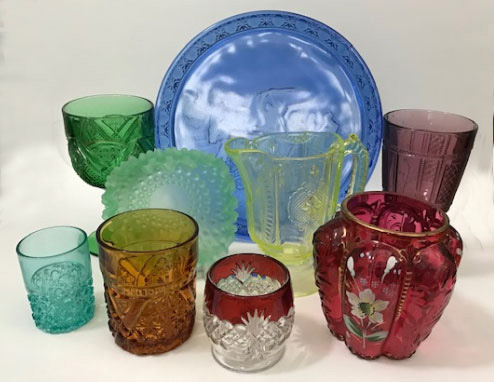
Most pattern glass was made crystal clear or colorless. Early on, a few, now precious flint pieces were colored – deep cobalt blue, amber, various shades of green, canary (what we now call vaseline) and a deep, rich amethyst. As we saw during the “hey day” years non-flint glass began to appear in some patterns in sapphire blue, light and dark amber or ʻold goldʼ, apple green (a bluish light green) emerald green, vaseline/ canary & occasionally in cobalt blue or deep amethyst. EAPG was never made in red glass. Any red on EAPG was a stain or paint on clear glass. EAPG was also never originally made in light purple color. EAPG seen today in that color is actually clear glass that has been turned by long time exposure to sunlight or placing it in direct contact with UV rays from the sun for a period of months – or with UV rays from a germicidal lamp for a shorter period – weeks. This serious problem has ruined and taken thousands of pieces of originally clear EAPG off the antiques market.
A few more items of interest about this fascinating glass are that through lo, these 70 (or so) years, the sizes of the forms, especially stems, changed hardly at all! Goblets were always 6” tall (give or take an inch); Champagne stems were all 5” tall (give or take); wine goblets were all 4” tall (give or take) and cordials were all 3” tall (give or take). Creamers were large because Victorians, especially farming families “grew” their own cream and used a lot of it. Sugar bowls were large because sugar came in chunks and they are covered because of insects & humidity. Master salts were gradually replaced by shakers during the 1880s and ʻ90s as granulated salt became available. And small pots or jars were popular to hold horseradish and mustard, commonly used condiments to hide the taste of meat, which was often, shall we say, past fresh.
What most resources and references about EAPG donʼt tell you is that this glass was the dishes of the “everyday (Victorian era) Housewife”. Wealthy people supped from fine china & blown glass drinking vessels brought across the sea from The Continent. Before American industry introduced this inexpensively made glass commodity, folks of slim means were mostly fed from metal, pottery or wooden plates and drank from primitive cups. One reason it was so inexpensive is that it was often made without the benefit of what we now call “Quality Control”. And so, many pieces exhibit what many now erroneously call “straw marks”, and/or rough spots from imperfect molds, and/or the ubiquitous enclosed or even burst bubbles and/or tilty or twisty pieces which ʻset upʼ askance after having been removed from the mold a little early.
A pet peeve of sellers of EAPG is the buyer who insists on what they call “mint” pieces of EAPG. Certainly few collectors are satisfied with harm, such as cracks, chips or UV caused purple discoloration, nor should they be. But “in-the- making” irregularities are part of the charm of our 100+ year old historical glass…. remember the lack of “Quality Control”. Coins are ʻmintʼ, pressed glass is irregularly molded and the term ʻmintʼ is inappropriate for it. “Undamaged” is our preferred term for EAPG which has not suffered any of the post-making above-mentioned harm.
So where and from whom is it safe to purchase “genuine” EAPG and not have to be concerned about not getting the “genuine” Early pieces?
We suggest starting at PatternGlass.com. Get a quick overview by reading, “What is EAPG” and then spend some time absorbing the Wisdom & Warnings at “Granny’s Pointers & Pitfalls”.
Where to buy it? Do beware of purchasing pattern glass on ebay. There is much listed there that is mis-identified – not on purpose, but by folks who simply have not studied pattern glass. Long-lived antique malls can be safe…and if you subsequently learn that a mistake was made in identification, it is easier to return it with a refund. Another good source of EAPG is estate sales such as are easily located on your computer at EstateSales.org .
We hope you will begin to love EAPG with a little more appreciation for itʼs historical story and try to imagine the life situation of the first owners of each piece as they struggled through the terrible War that divided our Country, Reconstruction as our ancestors put us back together, the incredible Westward expansion causing some pieces to be carted in covered wagons, the terrible Great Depression of the 1890s and the industrialization that emerged as we burst into the 20th century.
Whether obtained by inheritance from your great, great grandparents or you purchase pieces that belonged to someone elseʼs great, great grandparents, use it, enjoy it and let it remind you of days long gone by in America.
This article was written for EstateSales.org by Elaine Henderson. Elaine is a founding member of the Early American Pattern Glass Society. Her website can be found at PatternGlass.com.
